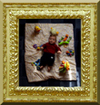JUNE 2018 - THIS week's PICTURE
Smithsonian Pillar Portrait: photo by Malcolm Aslett
|
|
| This slim outtake is from a much larger set of photographs that showed the whole front of the Smithsonian. By concentrating on the two figures and the central column the difficulty in finding a visually satisfying solution for all the forms was avoided. If you compare it with the image shown last week you can see that the central column has been worked on to be a continuous form in this one. There is one basic interplay with joiner photos and that is whether a line is perfectly contiguous between photos or is disrupted. That is played out time and again. And as human psychology tends to demand order there is a satisfaction experienced when the join is 'correct'. Not that the alternative is dissatisfaction as what is appealing then is the 'overall' fit of disparate parts. But they are different experiences. I know that David Hockney says that a joiner makes us look at a photo more closely because of the differences. It generally doesn't because people are lazy observers of their world. The psychology of seeing is all about short cuts. It would be more precise to say that a joiner photograph makes the odd person look more closely. Generally, we shift to a different manner of viewing that is almost as lazy but more cautious. So this image allows the eye to glide around three parts that are mostly 'gestalted' (I just made that word up, sort of). Their relationships with the other parts vary. The top right is quite disruptive and appears like a slash. The bottom left of the column and pedestal is a gentler blur into another order of things. The compromise is to lead the spectator to questions, to pander to visual pleasures at some points, to remind and provoke at others. |









